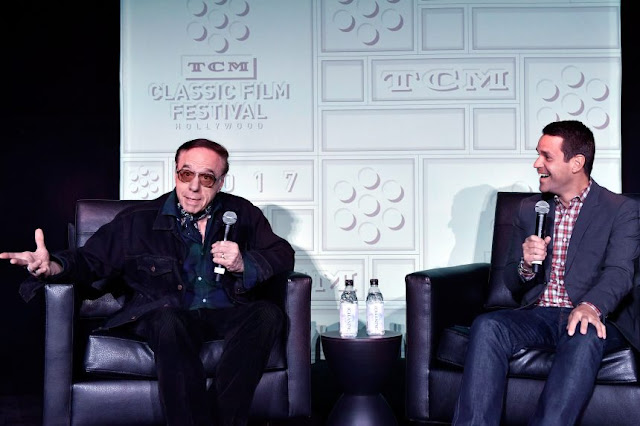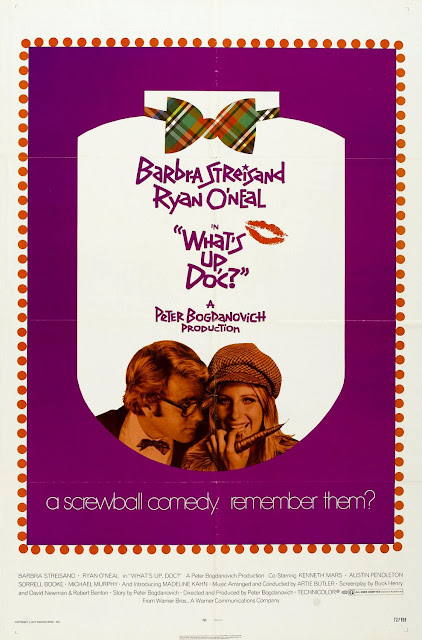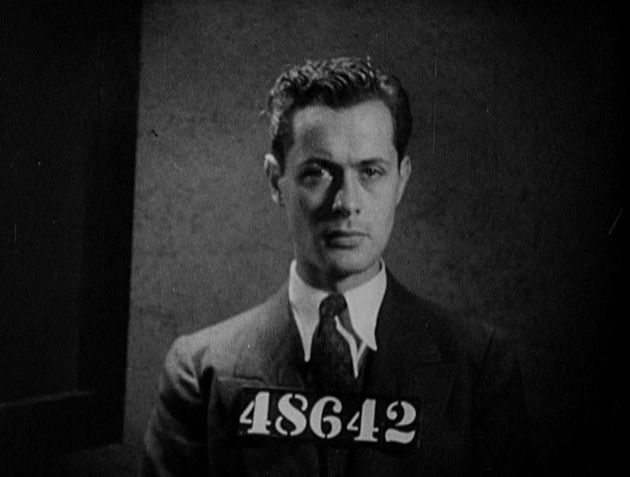 |
| Peter Bogdanovich and Dave Karger at the 2017 TCM Classic Film Festival - Photo source: Getty/TCM |
Director Peter Bogdanovich's follow-up to his Academy Award-winning drama The Last Picture Show (1971) was something wildly different. What's Up, Doc? (1972) is an homage to the screwball comedies of the 1930s and 1940s. Heavily influenced by Cary Grant and Bringing Up Baby (1938), it brought back a comedy style that was fun for the whole family. Bogdanovich insisted that it be a G-Rated picture making it a movie for adults but one they could take their kids to see.
What's Up, Doc? stars Barbra Streisand and Ryan O'Neal as a mismatched pair. O'Neal plays Howard Bannister, a musicologist attending a convention in San Francisco with his uptight fiancee Eunice Burns (Madeline Kahn in her film debut). His plaid overnight bag contains igneous rocks for his research project. Unfortunately for him, three delinquents who are up to no good also have identical plaid bags. Howard meets Judy (Barbra Streisand), a highly educated, free spirit who is hanging out at the hotel looking for amusement. She zones in on Howard and doesn't let go, much to the bewilderment of Howard's fiancee Eunice. Howard is desperate to get Judy off his back, to make things right with Eunice and to get the highly sought after musicology grant to fund his research. But as it is in screwball comedies everything goes hilariously wrong and builds up to one rip-roaring side-splitting climax.
What's Up, Doc? is a flat out funny film. But not everyone will agree with me. Streisand didn't think it was funny and I've heard from others who have tried to see the humor in this film but just couldn't. I love to laugh and have always had an appreciation for comedy in all its forms. I love the zaniness of What's Up, Doc? and this film is a new-to-me favorite. I saw it for the first time at the 2017 TCM Classic Film Festival, just one day before my very first visit to San Francisco.
At the festival entertainment host Dave Karger interviewed director Peter Bogdanovich before the start of the film. One of the things I admire about Bogdanovich is how much he loves and appreciates classic movies. In the interview he said that his favorite genre of film is the screwball comedy, in particular The Awful Truth (1937), The Lady Eve (1941), Twentieth Century (1934) and Bringing Up Baby (1938). Screenwriter David Newman came up with the title What's, Up Doc?, a reference to Bugs Bunny which is also called out in the film when Judy greets Howard saying the famous phrase while munching on a carrot. Bogdanovich said, "I loved the title because it's a catchphrase we all grew up with."
What's Up, Doc? came about because of Barbra Streisand. She had seen Bogdanovich's The Last Picture Show and wanted to work with him. Streisand had just done a comedy and was looking for a drama. Bogdanovich had just done a drama and wanted to work on a comedy. With the support of John Calley, head of Warner Bros, Bogdanovich proceeded with his idea for a contemporary screwball comedy. Writers Buck Henry, David Newman and Robert Benton worked on a original screenplay based on Bogdanovich's concept and it was full steam ahead for What's Up, Doc?.
As you can see in the trailer Bogdanovich was a very hands on director. Streisand had fun making the movie but got annoyed when Bogdanovich's tried to give her direction on everything including how to sing the As Time Goes By number. She was also overshadowed by newcomer Madeline Kahn who's god-given talent for comedy was a surprise to Kahn herself.
As for the trailer, director of photography Laszlo Kovacs shot some behind-the-scenes footage without Bogdanovich's knowledge. They were working on a complicated camera move when Streisand was laying on a piano, slides off and then moves to sit next to Ryan O'Neal. Bogdanovich acts out the scene with O'Neal as you can see in the trailer.
And that epic car chase scene? It took up a good chunk of the budget and production time. Filmed on location on the streets of San Francisco, it used multiple vehicles and lots of gags. My favorite scene is when the vehicles careen by two workers holding up a pane of glass and a man on an impossibly tall ladder hanging up a sign. It's so much fun to watch. Karger asked if it was true that the car chase scene was 25% of the film's budget. Bogdanovich replied, "Yes it was. The picture cost more than $6 million which is nothing compared to today's pictures. John Calley [head of Warner Bros.] called me on the first day of shooting we were in San Francisco in the airport. And John says, the chase scene is going to cost a million bucks. I said, well that's fine. He said, can you cut it down a little bit? I said no, I think it's going to be the high point of the picture. He said, if we make a deal with McDonald's can you bring McDonald's into it? I said, I can have them wreck a McDonald's. The deal never went through."
No Peter Bogdanovich interview would be complete without some impersonations. He treated us to a Cary Grant one which is always a treat. Bogdanovich told Grant that his movie was going to play at Radio City Music Hall. Grant replied "that's nothing! I had 28 picture play at the Hall. I tell you what you must do. Just go there and stand in the back. And you listen and you watch while 6,500 people laugh at something you did. It will do you a lot of good."
I love discovering new favorite movies at the TCM Classic Film Festival. It's the perfect venue for discovery especially when there is a special guest on hand to discuss the film. If you haven't seen What's Up, Doc? yet, it's available for streaming on Warner Archive Instant.





















